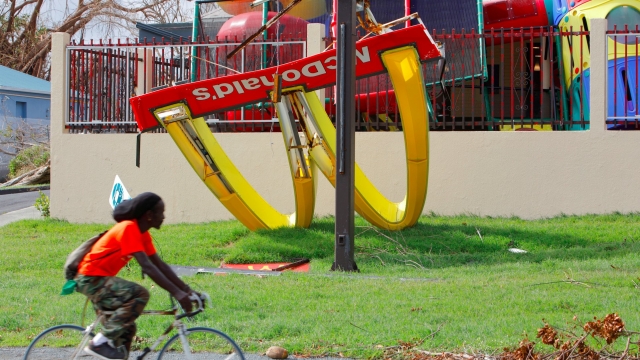
We should turn Puerto Rico into a haven for climate and clean energy research
http://ift.tt/2g8jtAF
Jonathan Drake/Reuters
It’s not too soon to start thinking about how to rebuild Puerto Rico’s cratered power infrastructure. Right now, 85% of the island is still without power and Puerto Ricans are still struggling for basic necessities like safe drinking water.Restoring both, but especially the latter, are urgent priorities.But if the territory is going to make a sustained recovery from Hurricane Maria, as well as the economic nightmare it was already facing before the storm hit, then serious forward thinking is necessary. Turning the island into a lab for green energy — solar, wind and tidal — does not seem like something Washington D.C. politics can endure. It’s been hard enough to get DC to respond to the humanitarian crisis that’s left thousands of American citizens in despair. And the Environmental Protection Agency has just announced it is reversing ex-President Barack Obama’s Clean Power Plan.The good news is that the territory’s governor seems interested — and open to find help outside of Washington. Before Hurricane Maria hit the island three weeks ago, Puerto Rico’s economy was already reeling from an 11-year recession, and grappling with a historic municipal debt bankruptcy. The island’s public electricity utility contributed to the financial straits because it was seriously outdated, prone to failing, and costly to keep up. It was dependent on oil (imported) and the grid itself was above ground and thus exposed to the elements. "Merely propping up aging infrastructure will not be effective," says Simon Johnson, former chief economist at the International Monetary Fund, who has studied Puerto Rico’s debt situation, in an opinion piece for Project Syndicate. "Cheaper and more resilient electricity benefits everyone – from the sidewalk vendor to the most sophisticated pharmaceutical operation. And all the technology needed to provide it is available in the US today."
He estimates that least 50% of the island’s energy could come from renewables like solar, wind, tidal, and other technologies. This would ease costs for businesses and individuals, who are often forced to rely on expensive diesel-powered generators during frequent blackouts.
"Imagine Puerto Rico becoming the electric vehicle capital of the world, with well-apportioned recharging stations, near-zero emissions, and car sharing for the tourism sector," Johnson, a professor at MIT’s Sloan School of Business, writes. "Puerto Rico could even become an energy exporter, supplying excess capacity to nearby neighbors in the US and British Virgin Islands."
Making Puerto Rico a green energy haven is thus a matter of political will, not financial capacity. But with the former lacking, the latter may have to come in large part from the private sector.
Tesla CEO Elon Musk recently said the company’s batteries and solar panels could help restore electricity to Puerto Rico if residents and the government decide they want to pursue that option.
He said on Twitter last week Tesla has already used a combination of its solar panels and Powerpack batteries to power a couple of small islands. He said that there is "no scalability limit" and that Tesla could build a similar system in Puerto Rico.
Musk is rushing to help, no doubt because it’s a great chance to prove what his technology can do. But he shouldn’t be the only CEO that sees the potential for Puerto Rico to be built for the 21st century.
NOW WATCH: 6 airline industry secrets that will help you fly like a pro
See Also:
- Puerto Rico stands ‘on the brink of a massive liquidity crisis that will intensify’
- We should turn Puerto Rico into a haven for climate and clean energy research
- A Puerto Rico bondholder strikes a far more sympathetic tone toward the island’s tragedy than Trump
SEE ALSO: A Puerto Rico bondholder strikes a far more sympathetic tone toward the island’s tragedy than Trump
business
via Business Insider http://ift.tt/eKERsB
